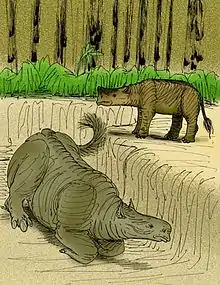Crivadiatherium
Crivadiatherium is an extinct genus of Palaeoamasiidae, which fossil remains—teeth and mandible fragments—have been discovered in the Crivadia site in the Hațeg depression, Romania. The age of the Crivadia site is not clear, but seems to be between the Late Eocene to the Early Oligocene. The teeth of Crivadiatherium, compared with those of its relatives as Palaeoamasia from Turkey and Arsinoitherium from Egypt, shows features more primitive, with lower molars without lobes and less bilophodont. It is probable that Crivadiatherium lived in lacustrine environments, maybe eating abrasive plants.[1][2]
| Crivadiatherium Temporal range: Late Eocene – Early Oligocene | |
|---|---|
 | |
| Brachydiastematherium transylvanicum and Crivadiatherium mackennai | |
| Scientific classification | |
| Kingdom: | Animalia |
| Phylum: | Chordata |
| Class: | Mammalia |
| Order: | †Embrithopoda |
| Family: | †Palaeoamasiidae |
| Genus: | †Crivadiatherium Radulesco, Iliesco & Iliesco 1976 |
| Species | |
| |
References
- Radulesco C., Sudre J., 1985. Crivadiatherium iliescui n. sp., nouvel Embrithopode (Mammalia) dans le Paléogène ancien de la dépression de Hateg (Roumanie). Palaeovertebrata 15 (3): 139-157.
- "Fossilworks: Crivadiatherium". fossilworks.org. Retrieved 17 June 2015.
This article is issued from Wikipedia. The text is licensed under Creative Commons - Attribution - Sharealike. Additional terms may apply for the media files.

